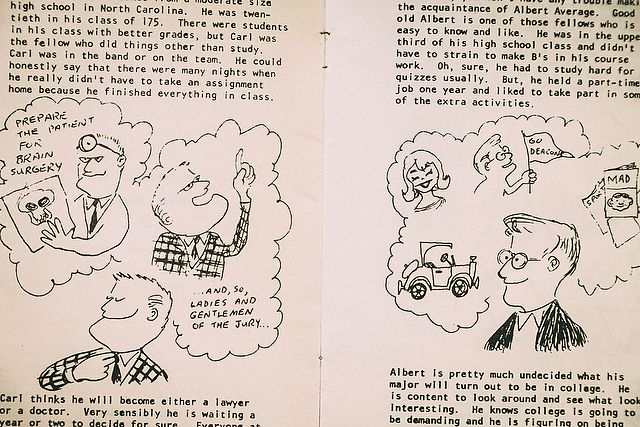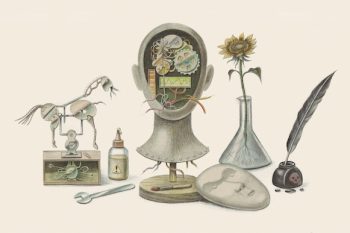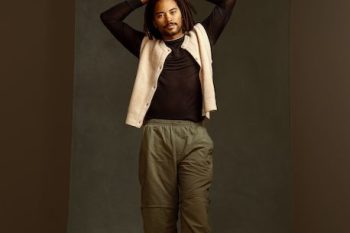After hearing from alumni with their generous suggestions and seeking advice from the campus community, Wake Forest Magazine curated this random collection of objects, from the whimsical to the serious and the historic to the fleeting (dress codes, anyone?). This assemblage humbly offers a few answers — but by no means a complete list — to an endless inquiry: What things make Mother so dear, not to mention fascinating?
P.O. BOXES

It weighs about 11 oz. and is worth about a $1, if sold for scrap. But for many alumni — especially those of us who arrived on campus before the invention of cell phones, email and texting — the 11 oz. brass door that opened our campus post office boxes was priceless. (They were removed from Poteat after postal operations moved to Benson in 2013.) The post office box was the link to friends and family back home. If you were lucky, you’d open that door to find a handwritten letter from your parents or hometown honey. If you were luckier still, you’d find a jackpot slip of paper that directed you to the P.O. counter. Awaiting you might be a care package from home. What lay behind that little brass door? Monday through Saturday it was worth a Quad cruise to find out.
WAKE FOREST/MICKEY MOUSE T-SHIRT FROM THE 1979 TANGERINE BOWL

Photo Courtesy Kent Newsome
Kent Newsome (’82) of Bellaire, Texas, stopped by Wake Forest Magazine with his family last year to say hello and share a few college memories. No surprise to anyone from that era, the Tangerine Bowl was the showstopper despite defeat. (Louisiana State 34, Wake Forest 10.) “I’ve still got my Mickey Mouse T-shirt,” said Newsome, now a top real estate lawyer in Texas. We asked for a photo and for Newsome’s description of its significance to him and his daughter Delaney:
“This T-shirt and a seemingly indestructible plastic Fideles cup are the only tangible remnants I have from my time at Wake Forest. Even my diploma was misplaced somewhere along the way. The trip to Orlando in December of 1979 with two of my roommates — in my mom’s big, blue Ford LTD — remains one of my favorite memories, and was definitely one of the best road trips ever. Even though the Deacons lost the game, we had a blast hanging out with our friends and other Deacon fans at Walt Disney World, and before, during and after the game.
“I love this shirt because it is a bridge between my magical (to me) and mythical (to my kids) formative years at Wake Forest and my adult life a thousand miles away, in Texas. Delaney grew up watching Wake Forest sports and understanding how the frequent disappointments make the high points even better. After Wake won the ACC football championship in 2006, she began to decorate her school notebooks with Deacon stickers and graphics. When we went to Walt Disney World in 2011, she wore this shirt. It’s been hers ever since.
“Wake Forest is a special place. It’s too easy to forget how special when you live far away and don’t get back to campus as often as you’d like. Seeing my daughter wearing my 1979 Wake Forest shirt reminds me how lucky I was to be there and how lucky I am to be here.”
DEMON DEACON MASCOT
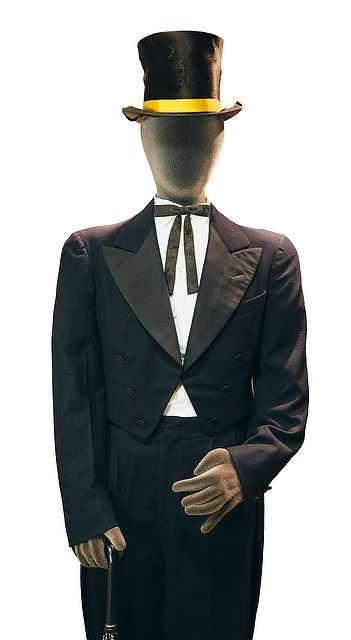
Homecoming 1941 marked a milestone that forever changed Demon Deacon lore. Some 18,000 fans packed Groves Stadium to see Wake Forest take on Southern Conference rival North Carolina.
The crowd erupted when junior Jack Baldwin (’43, P ’70), on a dare from his Kappa Sigma fraternity brothers, rode into the stadium on the back of the Carolina ram and waving an umbrella. And what was he wearing? It was an old tuxedo, tie and top hat, borrowed from his landlady whose husband had just died. The Howler put it this way: “Strutting Jack Baldwin dressed in his Deacon’s frock-tail coat and top hat put on a one-man circus.”
Others had dressed as an old Baptist Deacon from time to time, but no one captured the spirit of the Deacon like Baldwin. What started as a joke became a tradition. Baldwin donated the umbrella, tuxedo, tie and top hat he wore that day to the Wake Forest Historical Museum. He died in 2007, but the spirit of his Homecoming appearance lives on.
OUR BALINESE GAMELAN

Metals forged, wood precisely carved and details painted in gold and red, the Wake Forest gamelan was completed by artisans in Bali in December 2014, loaded into four shipping crates and launched on its four-month journey across the seas to a port in Norfolk, Virginia, then south to the Scales Fine Arts Center. On Oct. 29, 2015, students and members of the community wearing traditional Balinese costumes played its instruments in an inaugural concert on the Brendle Recital Hall stage.
 The room was silent, though, as I Madé Lasmawan, born in Bali and a composer of the island’s music, lit incense that rested atop a bowl of red carnations and fruit. He prayed aloud, barely audible in his invocation. He then took a blossom, dipped it in water and flicked droplets onto the instruments in blessing. Soon Wake Foresters would learn that in the ways of Balinese tradition the composer and music teacher at Colorado College had just named our new instruments Gamelan Giri Murti — a Balinese name that translates to “magical forest.”
The room was silent, though, as I Madé Lasmawan, born in Bali and a composer of the island’s music, lit incense that rested atop a bowl of red carnations and fruit. He prayed aloud, barely audible in his invocation. He then took a blossom, dipped it in water and flicked droplets onto the instruments in blessing. Soon Wake Foresters would learn that in the ways of Balinese tradition the composer and music teacher at Colorado College had just named our new instruments Gamelan Giri Murti — a Balinese name that translates to “magical forest.”
 The gamelan is a percussion orchestra consisting of gongs of various sizes, drums, flutes, cymbals and keyed instruments to be struck with mallets. Ours is a hybrid gamelan kembang kirang, “the only one of its exact kind,” says Elizabeth Clendinning, the ethnomusicologist and faculty member who commissioned its creation on behalf of the University. Traditionally played for village ceremonies and funerals, this type of gamelan has “a bittersweet sound” reflecting emotions.
The gamelan is a percussion orchestra consisting of gongs of various sizes, drums, flutes, cymbals and keyed instruments to be struck with mallets. Ours is a hybrid gamelan kembang kirang, “the only one of its exact kind,” says Elizabeth Clendinning, the ethnomusicologist and faculty member who commissioned its creation on behalf of the University. Traditionally played for village ceremonies and funerals, this type of gamelan has “a bittersweet sound” reflecting emotions.
Clendinning expects to continue to direct an ensemble of students and interested community members to play this collection of 45 instruments that are central to Hindu life in Bali. “It’s taught by rote,” she says. “You imitate it until you get it.”
Based on its revered place in sacred world music, the percussion orchestra can be expected to perform anything but ordinary music in North Carolina. Our “magical forest” gamelan promises sacred sweetness and emotion — a vibrating, blessed link between Wake Forest and an island known for devotion, artistry and love.
MEMENTOES FROM THE QUAD ELMS
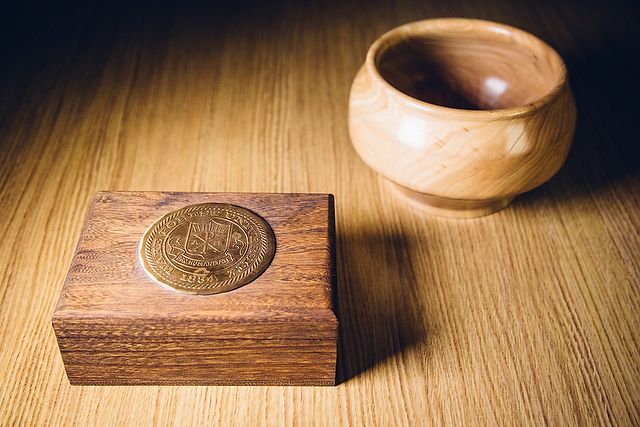
We graduated under their shade and celebrated athletic victories by festooning their branches with toilet paper. So when the majestic elm trees that had lined the Quad since the 1950s succumbed to Dutch elm disease in 1987, it was only fitting that we mourned by rolling them in memoriam.
In 1988, President Thomas K. Hearn Jr. paid tribute to the elms in his Commencement address. “Wake Forest has trees for a name. When we left the forest of Wake, the elms that stood here … were our environmental and emotional center. Their years have marked our seasons, shielded Commencement audiences from the sun, sheltered our games and walks, and celebrated our victories. These elms, like all gifts of beauty and love, were for a season.”
But the elms live on in our memories. Walter Sherrill (’82) remembers playing “Ep ball” with the trees’ spiky seedpods. Sigma Phi Epsilon fraternity brothers gathered the seedpods and assorted plastic bats for baseball-like games played in the Poteat dorm courtyard. “We’d collect boxes of them to have throughout the winter and into the spring,” Sherrill remembers. (A box of seedpods even made an appearance at the reception for a Sig Ep’s wedding.)
The elms live on, too, in various handcrafted keepsakes, including boxes and bowls. The late Professor of History Ed Hendricks (P ’86) gave small blocks of elm wood to students in his History of Wake Forest class in 1992. He taped this message to the block: “Its Demon Deacon proclivities are especially efficacious against Wolves, Heels or Blue Devils.”
OUR OWN BUTTON TO ‘SAVE THE SEAL’
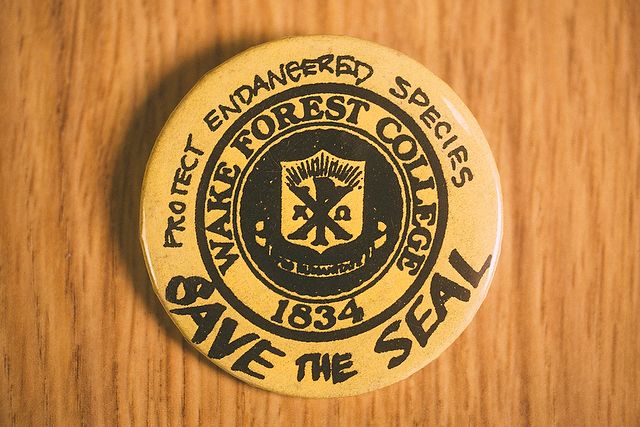
 You wouldn’t think that redesigning the University’s stationery would cause such a ruckus, but it did. The great seal caper erupted in 1984 when the administration unveiled the so-called “bar logo” to replace the Pro Humanitate seal on stationery and brochures. Some faculty members, including venerable history professor David Smiley (P ’74), saw more nefarious motives than a simple design change; the very principle of Pro Humanitate was under attack.
You wouldn’t think that redesigning the University’s stationery would cause such a ruckus, but it did. The great seal caper erupted in 1984 when the administration unveiled the so-called “bar logo” to replace the Pro Humanitate seal on stationery and brochures. Some faculty members, including venerable history professor David Smiley (P ’74), saw more nefarious motives than a simple design change; the very principle of Pro Humanitate was under attack.
Smiley waxed eloquently about the death of the seal in a sonnet in the Old Gold & Black: “Ay, tear her battered, tattered ensign down! Let’s throw it out. We threw out the gown, the Hickory stick, McGuffey, the dunce cap. Time for a new mission, with a new map. … More up to date than old Chi and Rho. … Pro Humanitate’s long day is past. … The tradition of tradition is dead.”
One wag launched a tongue-in-cheek campaign with this tiny button to “Save the Seal: Protect Endangered Species.” The Old Gold & Black waded into the fray in its April Fools’ edition, suggesting that a seal (a sticky, slimy, wet one) replace the Demon Deacon as the University mascot. The uproar quickly faded, and the bar logo survived for 25 years until it was replaced by the shield logo in 2009. Far from fading away, the seal is more revered than 25 years ago and more prominently featured on campus, including on the Quad in front of Reynolda Hall. And Pro Humanitate has never been stronger.
SAMUEL WAIT’S TRUNK
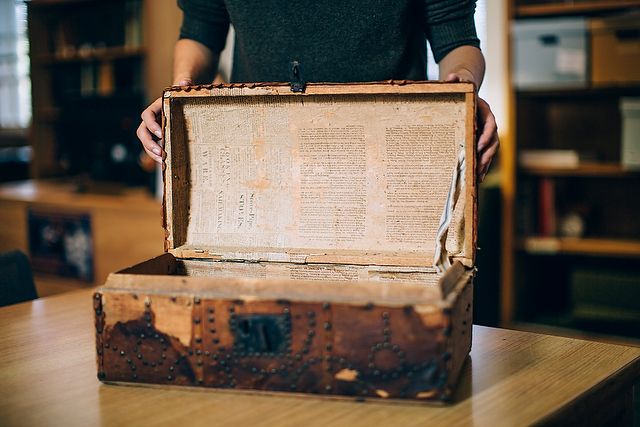
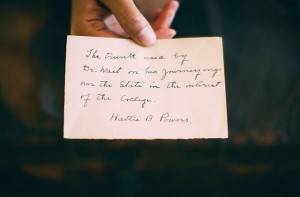 This small, wooden trunk belonged to Samuel Wait, Wake Forest’s founder and first president. Wait used the trunk when he traveled with his wife and baby daughter in a covered wagon across North Carolina in the early 1830s to raise money for the Baptist State Convention of North Carolina and Wake Forest Institute. The trunk is lined with pieces of newspaper from the Vermont Mirror dating to the Battle of Waterloo in 1815. Wait was born in New York state but moved with his family to Middlebury, Vermont, when he was a boy. Wait’s granddaughter, Hattie Brewer Powers, donated the trunk to the Z. Smith Reynolds Library Special Collections and Archives.
This small, wooden trunk belonged to Samuel Wait, Wake Forest’s founder and first president. Wait used the trunk when he traveled with his wife and baby daughter in a covered wagon across North Carolina in the early 1830s to raise money for the Baptist State Convention of North Carolina and Wake Forest Institute. The trunk is lined with pieces of newspaper from the Vermont Mirror dating to the Battle of Waterloo in 1815. Wait was born in New York state but moved with his family to Middlebury, Vermont, when he was a boy. Wait’s granddaughter, Hattie Brewer Powers, donated the trunk to the Z. Smith Reynolds Library Special Collections and Archives.
One strip of torn and faded newspaper inside the Wait trunk offers an intriguing account of Napoleon’s fate after the Battle of Waterloo. Napoleon surrendered to the British and was taken aboard the ship HMS Bellerophon. The newspaper account reads: “We have received from another correspondent the protest that Bonaparte made against his deportation to St. Helena. We are assured that the translation is a faithful one: ‘I protest solemnly, before God and man, against the violations of my sacred rights, which is committed, in deposing, by force, of my person and my liberty. I came voluntarily on the Bellerophon. I am not a prisoner. I am an inhabitant of the kingdom of England. From the moment I set my foot on board the Bellerophon I was under the protection of the English people.’ ”
Napoleon was later exiled to St. Helena. The trunk remains in our library.
DEELY BOBBERS (CURLERS) RULE BOOK

Imagine if, back in the ’50s and ’60s, those who monitored the dress code for female students had gotten their hands on a crystal curler and seen what the fashion future would bring. Advance knowledge of bellbottoms and miniskirts, disco boots and Daisy Dukes, parachute pants, pleather and omnipresent polyester might have changed their perspective when it came to a ban on wearing Bermuda shorts pretty much anywhere but Bermuda.
Absent proof of styles they could most likely never imagine, the solemn duty of those well-intentioned people was to make sure “The Wake Forest Woman” always showed good taste in her manners and appearance. And thanks to archived women’s student handbooks, we now know what to wear was actually as much about what not to wear.
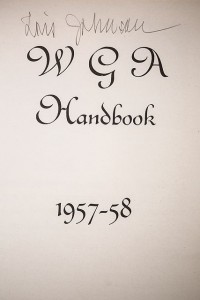 For example, if you were heading to Raleigh for shopping and a movie, hose were required when traveling to the state capital. We always knew those city folk were fancy. Hats and heels were expected for Sunday morning services, but hat-free heads were acceptable at athletic events. Too bad those were the days before deely bobbers. Bathing suits or playsuits were appropriate for sunbathing on Bostwick Beach, an activity prohibited before noon on Sundays.
For example, if you were heading to Raleigh for shopping and a movie, hose were required when traveling to the state capital. We always knew those city folk were fancy. Hats and heels were expected for Sunday morning services, but hat-free heads were acceptable at athletic events. Too bad those were the days before deely bobbers. Bathing suits or playsuits were appropriate for sunbathing on Bostwick Beach, an activity prohibited before noon on Sundays.
If a picnic or hike were on your schedule, blue jeans and pedal pushers were acceptable — (and gosh, actually comfortable). But you needn’t have thought about wearing them on campus or in the parlors, except in unusual circumstances. It’s not clear what those circumstances were, but one had to get permission from the local — er, proper — authorities.
And perhaps most importantly, cautioned the handbook, “You know how fussy boys are about appearances. When you are in the parlors make sure you look your best. When answering the phone be sure to slip on a raincoat, a pair of shoes and a scarf for those unsightly rollers.” That generation’s deely bobbers, perhaps.
CARL, AL & PERRY’S GUIDE TO WAKE FOREST
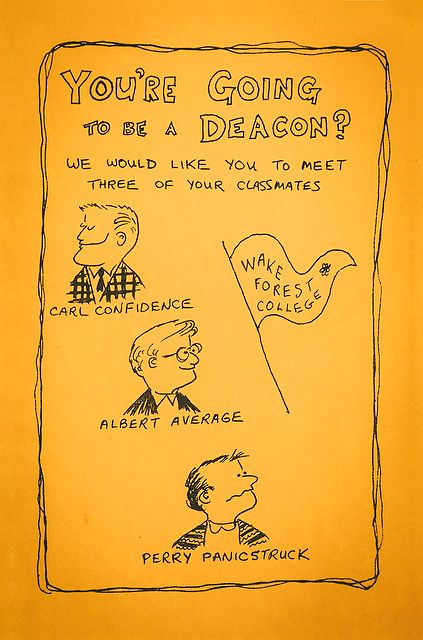
In 1964 Wake Forest College freshman males, who heretofore sought guidance from parents, mentors, Ouija boards and perhaps even tea leaves, received the “You’re Going to be a Deacon?” orientation booklet. Their new best friends became fictional “classmates” Carl Confidence, Albert Average and Perry Panicstruck, whose stories offered encouragement — along with realistic expectations — to those about to experience the challenges of managing college life.
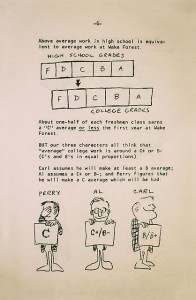 Carl, the fellow who came from a moderate-sized high school where everyone had better grades but who liked to do things other than study, finished assignments during the day so his evenings were free for extracurricular activities. When he made a C average his first semester, he wondered if he were losing his grip.
Carl, the fellow who came from a moderate-sized high school where everyone had better grades but who liked to do things other than study, finished assignments during the day so his evenings were free for extracurricular activities. When he made a C average his first semester, he wondered if he were losing his grip.
Affable Albert was pretty much undecided and content to look around and see what was interesting. In high school he didn’t have to strain to make Bs. But a “Gentlemen C” average first college semester? C’est la vie, said Al.
And poor Perry! He had considerable doubts about how the college thing was going to work. He graduated near the top of his class but wished people would quit expecting so much from him. He saw a C average as utter failure.
In the wise words of the freshman booklet, Carl assumed the college was waiting breathlessly for him. Perry assumed everyone else was smarter. Albert, bless his heart, settled for the easiest way through.
So what to take away from their experiences, asked Mother, so dear? Don’t be like those guys, who could have learned something valuable from each other. Be yourself; chart your own course. You got in, so you have what it takes to be successful at Wake Forest. No need for panic.
THINKPADS
(FOR SCHOOL AND WINPOP WARS)
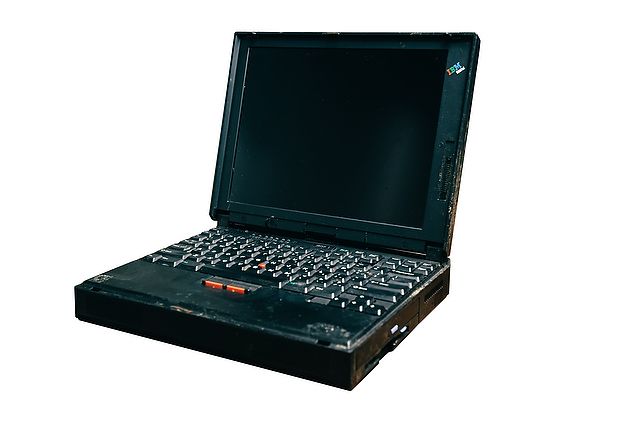
Photos by Joe Martinez ('06)
The incoming freshman class in 1996 received a school supply Wake Forest had never provided as part of tuition: a laptop.
As a way to give students a competitive advantage in an increasingly connected world, the University distributed to each first-year student in the Class of 2000 a 6.5-pound IBM ThinkPad 365XD.
“That model was like a brick,” says Jen Anderson (’00). “We’d carry them in these huge backpacks sagging down our backs.”
ThinkPads gave Wake Forest a scholastic and P.R. edge when students at other colleges remained largely in pen-and-paper mode. They also gave the Class of 2000 a social edge that didn’t require ringing a hall phone or cruising the Quad. After hooking up the ThinkPads to the dorms’ computer wiring, freshmen could use a program called WinPopup — nicknamed “WinPop” — for campus instant messaging. Jen and her friends would wage “WinPop Wars” with each other, firing off jokes and messages before heading out to whatever Friday night had to offer. WinPop became the preferred way to plan the weekend.
The victories won in the WinPop Wars of ’96 were soon forgotten, though, in favor of better instant messengers and better laptops. In 1998, when the Class of 2000 traded out their old ThinkPads for new 380XD ones, Jen saved hers, “partly out of nostalgia and partly out of wondering if it would ever be worth anything.”
The Class of 2000 can look back on their old laptops and still feel special, even elite. For Jen, those laptops were equivalent to owning the latest iPhone today. “The IBM ThinkPad was the thing to have,” she says.
Now Jen lives in San Francisco, where she works for a FinTech startup and runs fearlesscareer.com; and she knows exactly where her 6.5-pound ThinkPad resides, 3,000 miles away. Her mother in Madison, New Jersey, called her last year to remind her that “the brick” still waits for Jen in the basement.
